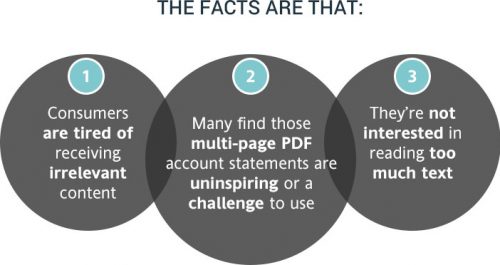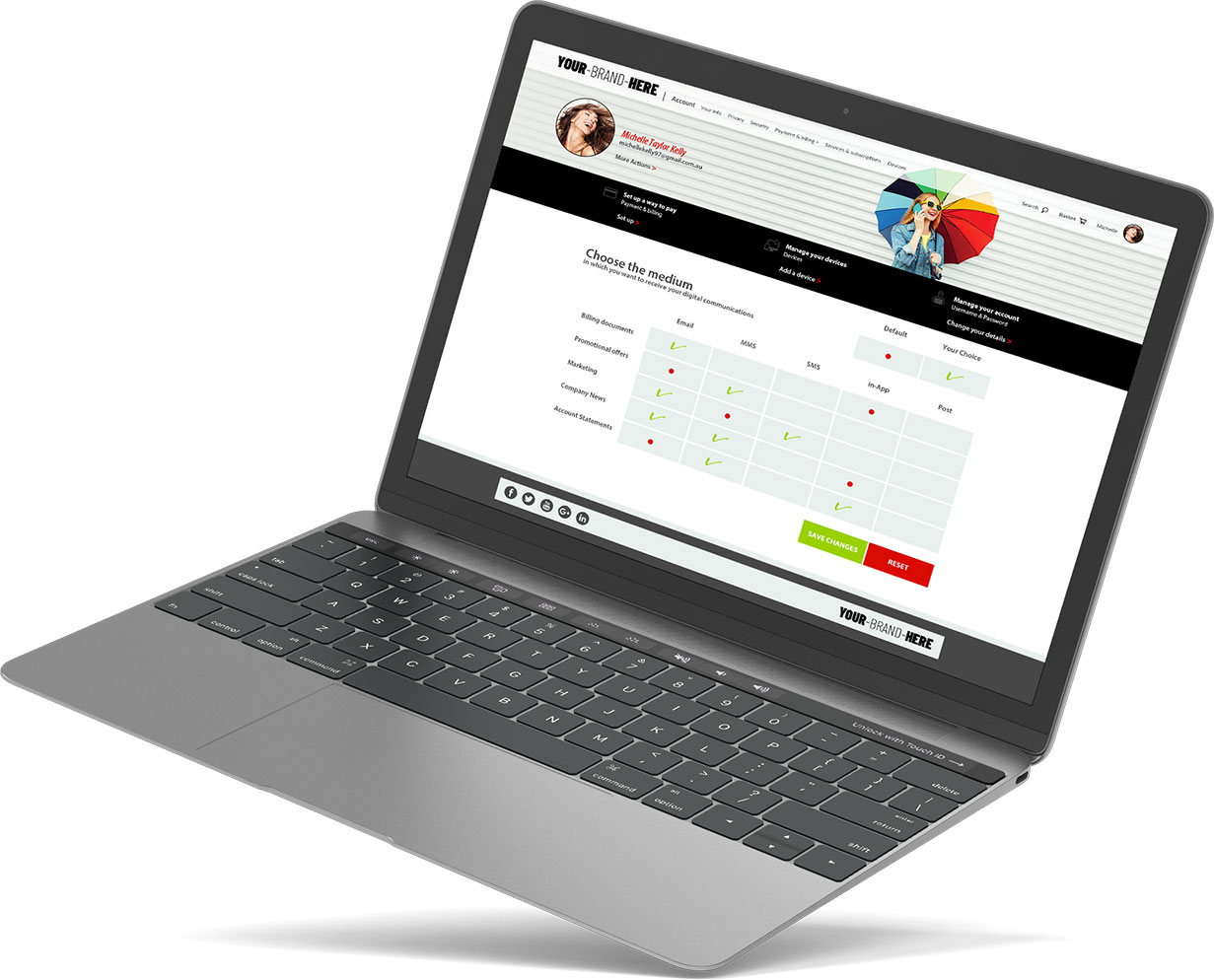GIVE US WHAT WE WANT
In this article, we outline five ways for companies to meet changing expectations about personalised and multi-channel communication, and how we help.
By Riaan Groenewald and Tim Eldridge

Many companies fail to deliver the communication experiences that customers like, want and value.
To illustrate the point, up to 80% of business-to-consumer emails campaigns are often ignored or deleted. That would not happen if the emails were well received and made customers look forward to the next one.

The implications are clear:
FIRST,
enterprises must create far more satisfying experiences if they want to improve the return on investment they make in customer correspondence.
SECOND,
enterprises must respond to consumer demand for additional communication channels – such as text and rich media messaging – and know when and how to move effortlessly and seamlessly between and across these extra channels.
In our experience, this requires businesses to master the following Five Imperatives For Customer Communication:

IMPERATIVE #1:
Put Customer Data To Work By Creating More Relevant Content

IMPERATIVE #2:
Fewer Words, More Graphics

IMPERATIVE #3:
Upgrade To Video-Based Story-Telling

IMPERATIVE #4:
Give Customers More Choice

IMPERATIVE #5:
Offer Interactive PDF Experiences & Personalised Web Pages

IMPERATIVE #1:
Put Customer Data To Work By
Creating More Relevant Content
Companies that do not treat their customers as individuals will soon start losing market share to those that do.
Much of the conversation about personalisation centres on moving ‘leads’ faster and more successfully through the sales funnel. While customer acquisition is an essential strategy for sellers, the more significant opportunity may rest with better leveraging the data generated on existing customers.
Harvard Business Review contributing editor Amy GalloI put it eloquently when she wrote, “depending on which study you believe, and what industry you’re in, acquiring a new customer is anywhere from five to 25 times more expensive than retaining an existing one”.
Data-rich and correspondence-intensive industries like insurance, banking and finance, telecommunications, internet service providers, retail and healthcare have much to gain from leveraging what they know about their customers to improve the relevance and appeal of their correspondence.
The upside is significant – higher Net Promotor Scores, stronger customer loyalty and increased customer lifetime value.
See associated article:
The Rise of Customer Communications Management And Why It Matters.
Synopsis: CCM software and managed services enable enterprises to streamline multiple communication channels into a single, all-in-one platform that conveys personalised offers and content to tens of millions of customers, simply.
Our Role
The iLiveIt platform creates a bridge between customer data sets and communication tools, enabling businesses to create and send personalised messages, offers, information, advice and other content at scale. We do this by extracting customer data from multiple sources in our client’s IT systems into a single view of the customer. Guided by predefined business rules, our platform and associated services then create personalised content dynamically at scale and is versatile enough to handle pretty much any digital touchpoint or communication channel.

IMPERATIVE #2:
Fewer Words,
More Graphics
Consumers have neither the time nor the inclination to read lengthy text-blocks or work through confusing tables inside account statements attached to emails as PDF’s.
Instead, they want attractive and straightforward ‘at-a-glance’ infographic presentations of data, information and content.
Creating visual representations of alpha-numeric information is straightforward when sending the same graphic to all customers. However, creating thousands or even millions of personalised graphics – optimised for individual customers – is beyond the ability of most enterprises.

Our Role
The iLiveIT platform and associated services can generate personalised infographic elements at scale and deploy them dynamically in a wide range of channels and experiences such as emails, videos, interactive PDF’s and other forms of digital or cellular connectivity.

IMPERATIVE #3:
Upgrade To Video-Based
Story-Telling
Consumers love video-based content.
Digital Marketing Services provider MySMNII says that while only
“20% of visitors read text on your page, 80% will watch a video”.
Forbes reports thatIII
“95% of consumers retain communicated information through video, while only 10 per cent retain information from reading”.
Hubspot reports thatIV
“If video and text are both available on the same page, 72% of people will watch the video to learn about a product or service rather than read the text.”
Our Role
iLiveIt’s video-production technology is optimised for personalisation.
We enable businesses to create thousands of personalised videos dynamically, incorporating scenes, captions, graphics and audio content selected/composed for individual recipients automatically, based on their customer data.
This innovative capability opens new possibilities for the use of video in customer correspondence.
See associated article:
Your Guide To Rapid Dynamic Personalised Video-Production (RDVP).
Synopsis: The future is not about creating a single video for, say, 10 million customers. Instead, enterprises will make ten million versions of a video – one for each customer, with personalised content.
For example, imagine that a telco provider discovered during research that its bills and statements are not well received and poorly understood.
In addition to improving the design of its statements, it decides to create short personalised videos for each customer explaining his or her data, voice, SMS and MMS usage records during the previous billing period.
By watching these videos, consumers might better understand their personal telco behaviour patterns and what’s driving the numbers in their statements.
These educational videos – which can be produced dynamically at scale – could also incorporate additional segments with messaging for consumers whose phones may be overdue for an upgrade or whose annual contracts are getting close to renewal.

IMPERATIVE #4:
Give Customers
More Choice
Text messaging is now reportedV to be the # 1 use for smartphones.
Research indicates that as a communication channel,
messaging outperforms email in terms of:

the speed with which recipients react to inbound correspondence, and

the percent of messages that recipients respond to/engage with
Mobile Marketing WatchVI, says that while “no one doubts that email still works” SMS is an awesome channel because “text messages have an off-the-charts open rate of 98 per cent”. Plenty of other reports support the general view that people read their SMS’s and respond to inbound SMS very quickly.
Apps such as WhatsApp, Facebook Messenger, WeChat, Skype, Snapchat, QQ Mobile, Line, Telegram and Apple’s iMessage all deliver messages ‘Over The Top’ (OTT) via data-networks. This is different from more straightforward SMS, and MMS platforms which use cellular networks.

More messaging innovation lies ahead.
- Over the next year or so we can expect to see an expansion of Google’s new Rich Messaging Service (RCS) which will bring the rich experience and versatile functionality of OTT messaging to cellular messaging.
- RCS is Android-only technology, which is partly why Apple developed Business Chat which, it promises, will offer consumers “a whole new way to talk to companies”.
In the meantime, given the popularity and immediacy of SMS, the additional functionality of MMS and emerging solutions like RCS/Business Chat, enterprises would be wise to consider that:
- Some customer communication tasks can and should migrate from email to SMS/MMS, or RCS/Business Chat in the future.
- Consumers increasingly expect to receive plenty of choice, flexibility and control over their preferred communication channel, including:
- The ability to switch from one channel to another whenever they wish, such as when going on vacation (and back again afterwards)
- The ability to select one channel for certain kinds of correspondence (such as email for product news) but another channel for different types of communication (such as SMS notifications for billing or MMS/RCS for personalised video updates).
Our Role
The iLiveIT platform was designed from the ground up as an unified-channel customer communication management platform. We can, therefore, support and enable your efforts to create personalised content and campaigns for SMS and MMS communication at scale.
Another significant benefit of a multi-channel approach is the ability to set up failover rules and actions. For example, an email bouncing back from a customer – perhaps because his or her mailbox is full – can be set up to trigger the automatic composition and delivery of the same content repackaged and restructured for MMS delivery. If the MMS fails, and SMS could be triggered. Similarly, SMS and MMS can be established as failover options if RCS/Business Chat communications were to fail.


IMPERATIVE #5:
Offer Interactive Pdf Experiences &
Personalised Web Pages
Multi-page PDF’s don’t need to be unimaginative, linear documents.
It is now possible to incorporate a variety of interactive design features that make PDF’s more exciting and user-friendly experiences on smartphones, tablet and computer.

Enable ‘one-click send-backs’ on return-required documents

Save customers time and hassle by pre-filling key fields on sign-up / data collection forms

Add compliant electronic signature fields to save customers the hassle of printing, signing, scanning & returning.

Add bookmarks and cross-reference tools to help customers navigate longer documents and skip to other pages or sections

Personalise – change the content to optimise the document for different customers
Moreover, the content of most PDF’s can now easily be repurposed to create personalised HTML pages too – which unlike PDF’S offer the benefits of a responsive environment. So why not go the distance and give the customer what they want – more choice and better experiences.
IN SUMMARY
Consumer preferences and expectations about the correspondence and communications they receive from companies is changing. They’re short on time, don’t want to read blocks of text, enjoy receiving information in graphical or video forms, uninterested in generic content and experimenting with new communication channels.
To thrive in this environment, enterprises need to change the way they communicate, correspond and notify customers at different stages in the customer journey. In our experience, mastering these Five Imperatives For Customer Communication Management is an excellent place to start.

IMPERATIVE #1:
Put Customer Data To Work By Creating More Relevant Content

IMPERATIVE #2:
Fewer Words, More Graphics

IMPERATIVE #3:
Upgrade To Video-Based Story-Telling

IMPERATIVE #4:
Give Customers More Choice

IMPERATIVE #5:
Offer Interactive PDF Experiences & Personalised Web Pages
(I) https://hbr.org/2014/10/the-value-of-keeping-the-right-customers
(II) https://mysmn.com/28-fun-facts-about-digital-marketing/
(III) https://www.forbes.com/sites/williamcraig/2018/04/24/the-growth-of-video-marketing-and-why-your-business-needs-it/#44dcd50e7c2d
(IV) https://www.hubspot.com/marketing-statistics
(V) https://www.marketingcharts.com/customer-centric-79000
(VI) https://mobilemarketingwatch.com/sms-marketing-wallops-email-with-98-open-rate-and-only-1-spam-43866/
Request More Information On
What The World’s Smartest CCM Platform Could Do For Your Business
We are happy to provide some examples and answer your questions.



